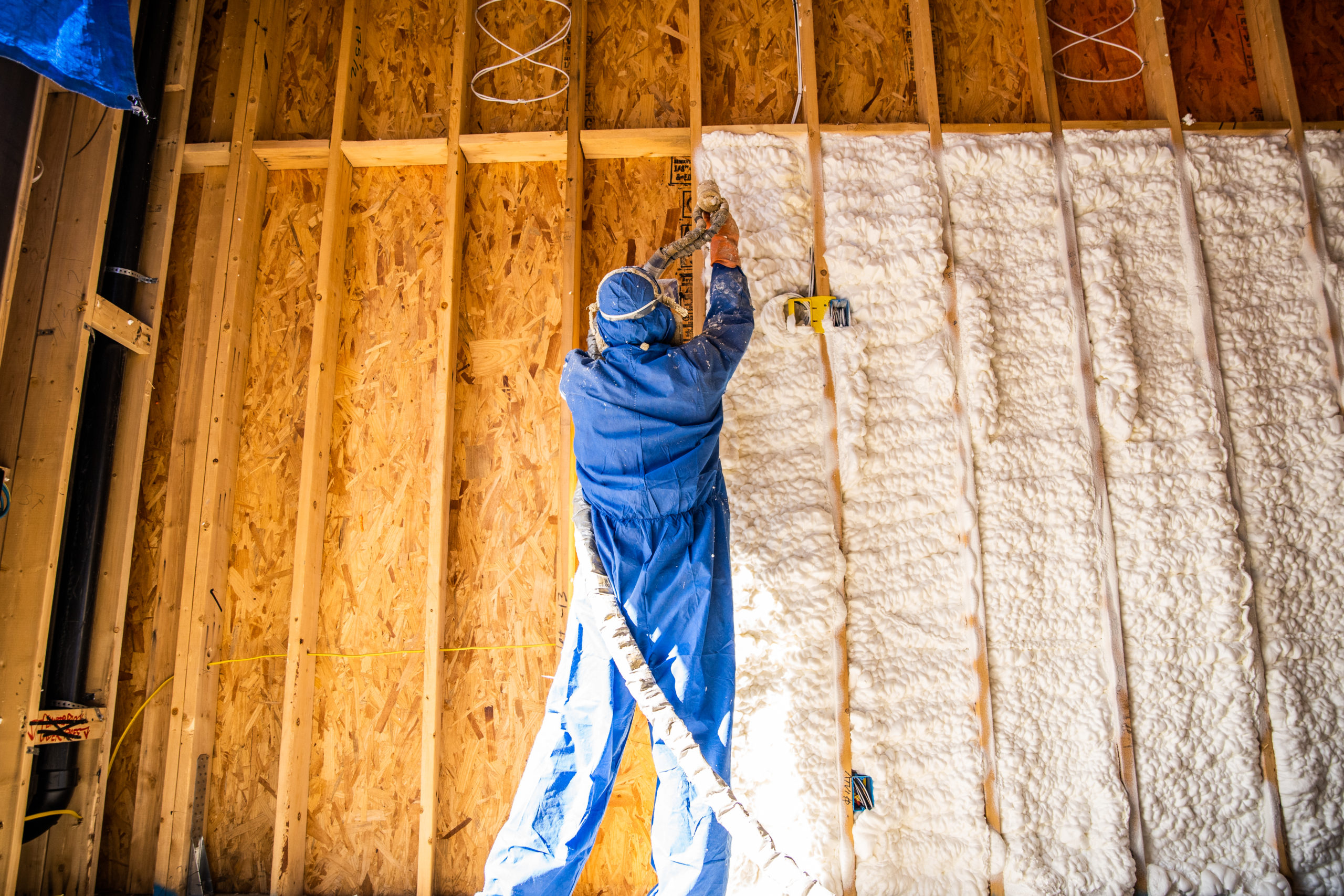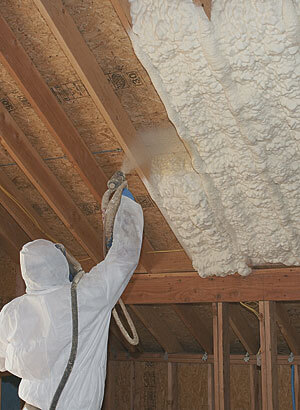Tips for Maintaining Your Spray Foam Insulation for Long-Term Performance
Tips for Maintaining Your Spray Foam Insulation for Long-Term Performance
Blog Article
Spray Foam: The Ultimate Option for Air Sealing and Insulation
Spray foam insulation has actually become a leading remedy for efficient air securing and thermal insulation, using a distinct combination of homes that set it besides conventional techniques. Its capability to broaden and fill gaps makes it specifically efficient in protecting against air leakage, which can considerably influence power performance. Nonetheless, comprehending the complete extent of its advantages, installment procedures, and contrasts with various other insulation kinds is vital for making notified choices. As we discover these elements, the ramifications for both brand-new constructions and retrofits end up being progressively considerable. What aspects should influence your choice?
What Is Spray Foam?
Spray foam is a versatile insulation material that integrates the concepts of air sealing and thermal resistance to enhance energy effectiveness in structures. Composed mainly of polyurethane or other similar compounds, spray foam is applied as a fluid that expands upon call with surface areas, producing a strong, continual layer of insulation. This one-of-a-kind building enables it to fill voids, cracks, and voids that traditional insulation materials might forget, giving an exceptional air seal.
There are 2 major kinds of spray foam: open-cell and closed-cell. Open-cell spray foam is lighter and extra adaptable, providing exceptional noise absorption and a lower R-value per inch - Spray Foam. In comparison, closed-cell spray foam is denser, offering a higher R-value, wetness resistance, and included structural integrity to building elements
The application procedure typically includes specialized tools, making certain a seamless application that sticks to different substrates, consisting of metal, wood, and concrete. This adaptability makes spray foam appropriate for both brand-new buildings and retrofitting existing frameworks. Its capacity to develop an airtight obstacle considerably contributes to reducing energy consumption and enhancing interior air top quality, thereby making it a preferred selection among property owners and builders alike.
Advantages of Spray Foam Insulation
One of the most substantial advantages of spray foam insulation is its remarkable capability to produce a constant air obstacle, which effectively lessens energy loss. Unlike typical insulation products, spray foam broadens to fill up cracks and gaps, ensuring that air leak is dramatically lowered. This particular not only boosts energy efficiency yet likewise results in lower energy costs over time.
In addition, spray foam insulation supplies superior thermal resistance, contributing to a much more secure interior atmosphere. Its high R-value per inch enables efficient insulation in restricted areas, making it excellent for attic rooms, wall surfaces, and crawl spaces. Furthermore, the moisture-resistant residential or commercial properties of spray foam assistance stop mold and mildew and mold growth, advertising much healthier living problems.
One more crucial benefit of spray foam insulation is its sound-dampening qualities (Spray Foam). It successfully minimizes sound transmission between areas, creating a quieter and a lot more comfortable home environment. The durability of spray foam additionally stands apart, as it does not sag or settle in time, preserving its performance throughout its life expectancy
How Spray Foam Works
Recognizing just how spray foam insulation works is essential for appreciating its effectiveness in air securing and thermal resistance. Spray foam insulation consists of 2 key components: isocyanate and polyol material. When these elements are combined, they go through a chain reaction that triggers the product to expand quickly, developing a thick foam that fills cracks, spaces, and cavities.
As the foam increases, it complies with surface areas, creating a closed seal that substantially lowers air infiltration. This characteristic makes spray foam insulation extremely reliable at avoiding drafts and wetness infiltration, which can lead to energy loss and damage over time. In addition, the closed-cell variant of spray foam offers exceptional thermal resistance due to its rigid structure, successfully decreasing warmth transfer.
The special residential properties of spray foam permit it to comply with irregular important site surfaces, making sure comprehensive coverage and a seamless obstacle. Therefore, spray foam insulation not just boosts power performance but also contributes to improved interior air top quality by lowering the buildup of irritants and toxins. Eventually, comprehending the auto mechanics behind spray foam highlights its role as a remarkable option for insulation and air sealing in both commercial and residential applications.
Setup Refine Introduction

Before setup, the room must be appropriately cleaned up and prepped, making sure that surfaces are devoid of dirt, particles, and moisture. Because pollutants can jeopardize attachment and total performance, this step is essential. As soon as the area is prepared, the application includes mixing the two elements of the spray foam, which increases upon call and loads voids successfully.
Trained experts should conduct the installation, utilizing specialized equipment to guarantee uniform protection and ideal density. Security preventative measures, consisting of using protective gear and guaranteeing correct air flow, are vital throughout this process. After application, the foam usually remedies swiftly, developing a solid visit the site obstacle that enhances energy effectiveness.
Contrasting Spray Foam to Traditional Insulation
When assessing insulation options, spray foam insulation stands out in contrast to conventional materials such as fiberglass and cellulose. Unlike fiberglass and cellulose, which can enable air infiltration, spray foam increases upon application, filling crevices and gaps to develop a closed seal.
In addition, spray foam supplies a higher R-value per inch than traditional insulation types, offering more reliable thermal resistance in a thinner profile. This particular is especially advantageous in spaces with restricted cavity deepness. Spray foam is resistant to dampness and mold growth, which can be a significant issue with cellulose and fiberglass, particularly in humid atmospheres.
Nonetheless, spray foam insulation normally lugs a higher in advance cost than its conventional counterparts. Property owners need to evaluate this first financial investment against long-lasting power financial savings and performance benefits. Eventually, while both insulation types offer their function, spray foam emerges as an advanced remedy for modern-day insulation demands, especially in terms of air my site securing and thermal performance.

Conclusion
In summary, spray foam insulation represents a very effective solution for attaining optimum air securing and thermal resistance. Its special residential or commercial properties, including moisture resistance and sound dampening, make it ideal for numerous applications in both brand-new buildings and retrofitting jobs (Spray Foam). The initial prices may be higher compared to standard insulation products, the long-term benefits, such as significant energy cost savings and boosted interior air quality, warrant the investment and highlight its value in modern building methods.
Spray foam insulation has emerged as a leading service for reliable air securing and thermal insulation, supplying a distinct combination of properties that establish it apart from typical approaches.Spray foam is a versatile insulation material that integrates the principles of air sealing and thermal resistance to boost energy performance in structures.When assessing insulation choices, spray foam insulation stands out in comparison to traditional products such as fiberglass and cellulose. Inevitably, while both insulation kinds serve their purpose, spray foam arises as a more advanced solution for modern-day insulation requirements, particularly in terms of air sealing and thermal efficiency.
In recap, spray foam insulation represents a very effective service for achieving ideal air securing and thermal resistance.
Report this page